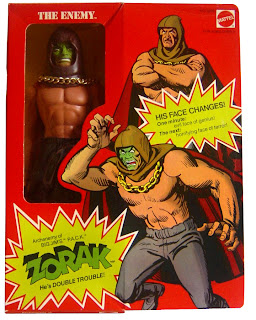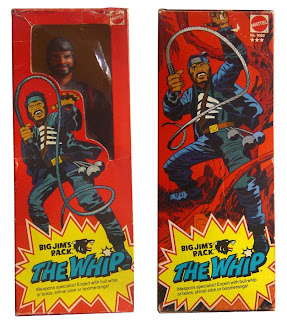I started this site because I have so much useless toy knowledge that my close friends and loved ones got tired of being bored to death with hearing about, so I figured I'd better find an outlet for it and hope that other people out there might find it informative or useful.
While I will continue to focus on specific toy lines from the 60's, 70's 80's and beyond, I wanted to do a quick but comprehensive run-down of the various toy companies and their toy lines from the past 50 years.
Now, obviously I can't cover everything-- so your favorite line might not make it into the bunch (even though mine will)-- I'm going to try to hit all the major ones along with a few "honorable mentions".
Starting things off is the decade that saw the creation of what we've come to know as the "action figure". This term was first coined when Hasbro wanted to create a "doll" for boys. It was to be the male version of what Mattel's Barbie was for girls. Wisely, Hasbro knew that trying to sell "dolls" to boy was a losing prospect, so they called their "doll"-- GI Joe in his 12" form-- an "action figure".
And so, in 1964, the very first posable "action figure" was born!
With that little bit of history behind us, let's delve into the toy companies of the 1960's with, what else but--
HASBRO
Originally called "Hassenfeld Brothers", brothers Henry and Helal Hassenfeld started their company way back in 1923. They started out producing simple things like pencil cases and toy doctor and nurse kits, but their first major hit was toy known as Mr. Potato Head in 1952. (FUN FACT: The original Mr. Potato Head only included the eyes, noses, etc, you had to use a real potato with the parts!)
Their first major foray into the boys toy market however was with a military themed 12" action figure series that they called G.I. Joe.
G.I. JOE
Created by Hasbro toy designer's Don Levine and Stan Weston, GI Joe was meant to be for boys what Barbie was for girls. (FUN FACT: G.I. stands for "Government Issued" with the term "GI Joe" representing the generic term for a soldier as it was coined during WWII.) There were four different boxed figures released, each representing a branch of the military. The single figures-- Action Soldier, Action Marine, Action Sailor and Action Pilot-- each came with their basic fatigues and a duty cap. The real meat of the line was in the different military accessory and clothing set that you could buy to accessorize your figures into different military looks.
One of the most noticeable features of the GI Joe figure was that each one featured a scar on his right cheek. While it became the GI trademark among kids, it was actually put there to prevent other companies from copying the mold. (FUN FACT: Hasbro also added an additional and lesser known counterfeiting measure to their figures-- a thumbnail that's molded on the underside of the thumb instead of on top where it would normally be!) Another feature of each figure was that they all came with metal dog tags around their neck. After the initial launch, Hasbro created the "talking" version of their regular figures, an action that was activated by pulling on their dog tags which were attached to a string that would work the talking mechanism located in their chest.
The original GI Joe military theme spawned dozens of uniforms and weapons sets, and even some vehicles and "foreign figures" based off of WWII Axies and Allied countries. But, by the end of the 60's the war in Vietnam was creating a rather large anti-war sentiment in the US and parents just weren't as apt to buy war themed toys for their children. Hasbro needed to make a change with their GI Joe line before it faded into obscurity forever...
MATTEL
Founded in 1945 by Harold "Matt" Matson and Elliot Handler-- which is also where the company derived its name. Mattel's first and possibly biggest success, even to this day, was in 1959 when Handler's wife (and president of Mattel), Ruth Handler, created a toy line for girls named after their daughter Barbara called Barbie.
From that point on, Mattel grew to become the largest toy manufacturing company in the US-- even to this day.
MAJOR MATT MASON
With the girl's market firmly in the palm of their hand, Mattel set their sights on the boy's figure market by tapping into America's fascination with the "space race".
In 1966, Mattel introduced Major Matt Mason. The figures were astronauts and most of the original designs and playsets were based on actual NASA prototypes. The figures didn't have any "swivel" style joints like Hasbro's GI Joe-- and were much smaller-- but instead featured a wire inner frame over a rubber suited body. This was a bit hit and miss in terms of design in terms of longevity, but it worked well enough for the time.
While Mason and his astronaut (and later, alien) pals were the stars of the series, what really stood out were all the amazing vehicles and playsets, which became the life-blood of the line.
The line lasted quite a few years, but in the early 70's interest in real-life space adventures died down, and interest in Major Matt Mason died with it. The line is still fondly remembered to this day and a possible resurgence is underway spearheaded by actor (and Matt Mason fan) Tom Hanks.
IDEAL
You may never have heard of-- or just don't remember the name-- Ideal (or Ideal Novelty and Toy Company, as they were known in 1907 when they were founded), but they may very well be the most famous toy company of all time due to one singular creation in 1903-- the Teddy Bear.
CAPTAIN ACTION
Toy designer and entrepreneur Stan Weston took the concept of a single hero that could turn into various licensed super heroes to Ideal after he'd help create the GI Joe line at Hasbro the year prior.
In 1966, Ideal Toy Corporation launched the 12" Captain Action toy line in stores across America. The figure was a character unto himself, complete with costume, hat, sword and gun. He even had his own villain, Dr. Evil. The gimmick of this line was that you could turn Caption Action into various popular super heroes like Spiderman, Batman, Superman and even pulp heroes like Buck Rogers and The Phantom.
Captain Action was a hit with kids, so much so that Ideal introduced Action Boy, a sidekick who had his own line of sidekick hero costumes to don.
At the height of Captain Action's popularity, Ideal released a companion line called SUPER QUEENS. This line was created in the hopes of capturing a bit of the female audience while at the same time give some female heroes to the Captain Action line. There were only four heroine released: Batgirl, Mera, Supergirl and Wonder Woman. These figures did not have costumes like Captain Action, but instead just stayed the characters they represented.
As popular as Captain Action had become, after only a few years, his sales declined dramatically and Ideal cancelled the line. All in all, Captain Action was only around for a little over 2 1/2 years-- and the Super Queens line even less than that. Because of this, boxed or packages Captain Action toys are some of the most rare in action figure history, the Super Queens even more so. A boxed Super Queen figure in collector level condition can easily fetch close to $10,000 from the right buyer.
COLORFORMS
Many people remember Colorforms from the 70's when they did boxed sets of flat vinyl characters that could be placed into background scenes that folded out from the interior of the box. They featured licensed characters like Spider-man or Superman, but we're talking about the 60's.
THE OUTER SPACE MEN
With the success of Mattel's Major Matt Mason line, Colorforms decided to enter into the boy's figure market by creating a line of alien figures that could be used in conjunction with Mattel's Mason line. In fact, Colorforms even aped Mattel's design, creating figures that were a rubber body over a bendable wire frame.
Each figure was from a different planet, like "Colossus Rex, the Man from Jupiter" and "Alpha 7, the Man from Mars".
The figures were not a major hit at retail, so the proposed second series never made it to production, although the prototypes still exist.
Once again, because of the rarity of these figures, they are some of the hardest to find in collector condition-- especially mint on card-- in all of action figure history and fetch very high prices loose-- and insane prices carded, should you ever be lucky to find even one.
(FUN FACT: The Outer Space Men have returned, thanks to the the famous toy sculptors/designers The Four Horsemen and original OSM creator Mel Birnkrant. This time out they are in a 3 3/4" scale the unproduced characters from the original second wave are finally now being released, too!)
~~~~~~~~HONORABLE MENTIONS~~~~~~~~
AMERICAN CHARACTER TOY
BONANZA
MARX
JOHNNY WEST




















































